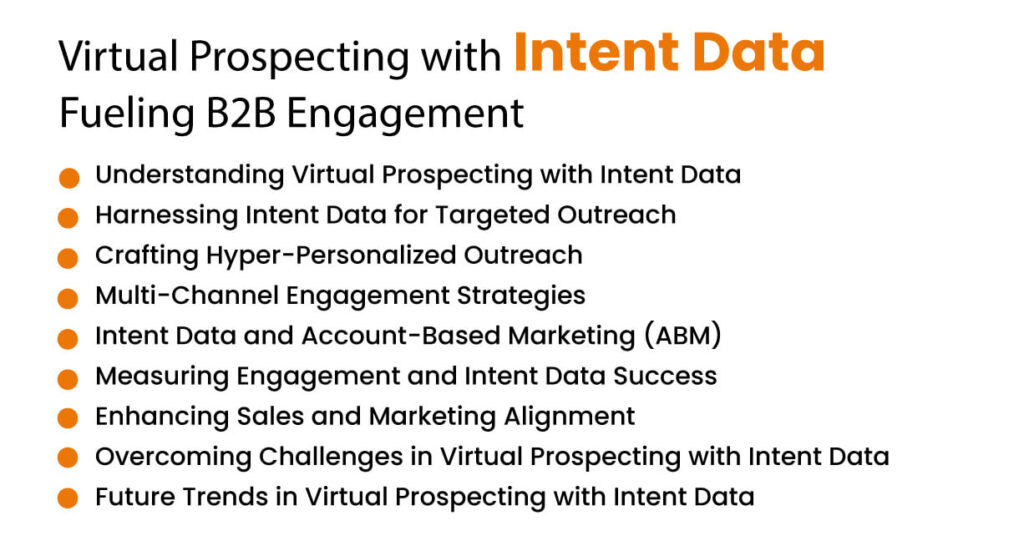
B2B prospecting has evolved significantly in the digital era. The traditional methods of cold calling and generic outreach have given way to a more sophisticated approach that leverages data and insights to connect with prospects who are genuinely interested in your offerings.
This evolution has led to the rise of virtual prospecting, a strategic process that harnesses the power of intent data for more meaningful engagement.
Intent data has emerged as a game-changer in B2B prospecting. It provides insights into the online behavior of potential buyers, helping sales and marketing teams identify prospects who are actively researching solutions similar to what they offer.
This knowledge enables virtual prospecting efforts to be hyper-targeted and relevant, leading to higher engagement rates and more qualified leads (Sales qualified or Marketing qualified).
In this comprehensive guide, we’ll explore the synergy between virtual prospecting and intent data. We’ll delve into how intent data can be harnessed to drive targeted outreach, create personalized interactions, and foster more meaningful connections in the digital B2B landscape.
Must Read: Intent Data: A Game-Changer for B2B Event Marketing
Virtual Prospecting with Intent Data: Fueling B2B Engagement
Table of Contents
- 1 Virtual Prospecting with Intent Data: Fueling B2B Engagement
- 1.1 Understanding Virtual Prospecting with Intent Data
- 1.2 Harnessing Intent Data for Targeted Outreach
- 1.3 Crafting Hyper-Personalized Outreach
- 1.4 Multi-Channel Engagement Strategies
- 1.5 Intent Data and Account-Based Marketing (ABM)
- 1.6 Measuring Engagement and Intent Data Success
- 1.7 Enhancing Sales and Marketing Alignment
- 1.8 Overcoming Challenges in Virtual Prospecting with Intent Data
- 1.9 Future Trends in Virtual Prospecting with Intent Data
- 1.10 Conclusion
- 1.11 Share this:

Understanding Virtual Prospecting with Intent Data
Virtual prospecting involves using digital channels to identify and engage with potential B2B buyers. Intent data, on the other hand, refers to the signals and cues that indicate a prospect’s active interest in a particular topic, solution, or industry.
Combining these two concepts means reaching out to prospects who are not only within your target audience but also exhibiting clear signs of interest.
Must Read: Intent Data for Lead Generation
A. The Role of Intent Signals in Targeted Outreach
Intent signals act as guideposts in the digital wilderness, directing sales and marketing teams toward prospects who are actively seeking solutions.
These signals can range from website visits and content downloads to keyword searches and engagement with industry-related content.
Identifying and interpreting these signals enable teams to prioritize their outreach efforts and engage with prospects at the right moment.
B. Benefits of Combining Virtual Prospecting and Intent Data
The amalgamation of virtual prospecting and intent data offers a range of benefits. By focusing on prospects who are displaying intent signals, teams can significantly increase the efficiency of their outreach efforts. This approach leads to higher response rates, more meaningful conversations, and a shorter sales cycle.
Must Read: Driving Growth with B2B Purchase Intent Data: Unlocking the Power of Buyer Insights
Harnessing Intent Data for Targeted Outreach
A. Tracking Online Buyer Behavior and Signals
The online world provides a wealth of data about buyer behavior. Intent data allows you to track what content prospects are consuming, which websites they’re visiting, and what keywords they’re searching for. This insight into their digital footprints provides a clearer understanding of their interests and needs.
B. Identifying Real-Time Purchase Intent
Intent data is most powerful when it’s captured in real-time. This means that as prospects engage with content, browse websites, or participate in online discussions, their intent signals are captured immediately. This real-time information enables your virtual prospecting efforts to be timely and relevant.
C. Analyzing Intent Data to Uncover Prospect Needs
Intent data goes beyond mere signals; it offers a window into the challenges and pain points that prospects are trying to address. By analyzing their online behavior, you can deduce the problems they’re grappling with and tailor your outreach to address those specific needs.
Must Read: B2B Intent Marketing: Capturing Business Leads
Crafting Hyper-Personalized Outreach
A. Tailoring Messaging Based on Intent Signals
Intent data allows you to tailor your messaging to align with the prospect’s interests. When reaching out, reference the specific content they’ve engaged with or the topics they’ve shown interest in. This level of personalization immediately grabs their attention and establishes your relevance.
B. Addressing Prospect Pain Points and Interests
Intent data reveals pain points and interests that prospects may not have explicitly stated. Use this information to craft messages that directly address their challenges and aspirations. According to HubSpot, personalized emails deliver six times higher transaction rates.
C. Adding Value through Relevant Content
Content remains a potent tool in virtual prospecting. Leverage intent data to send prospects content that aligns with their interests. This not only showcases your expertise but also positions you as a valuable resource in their decision-making journey.
Must Read: How To Make The Most From Your Customer Acquisition Marketing
Multi-Channel Engagement Strategies
A. Leveraging Email Outreach with Intent Insights
Email is a primary channel for virtual prospecting. When armed with intent insights, you can draft compelling subject lines and content that resonate with the prospect’s interests. According to Statista, the global average open rate for B2B emails is around 21.33%.
B. Integrating Social Media Engagement for Warm Connections
Social media provides an avenue for warm interactions. Engage with prospects on platforms like LinkedIn by commenting on their posts, sharing relevant content, and initiating conversations. This familiarity can pave the way for more receptive virtual prospecting efforts.
C. Incorporating Intent Data in Cold Calling
Cold calling becomes more effective when combined with intent data. Before making a call, review the prospect’s intent signals to understand their context and tailor your conversation accordingly. This approach transforms cold calls into warm conversations.
Intent Data and Account-Based Marketing (ABM)
A. Mapping Intent Data to Target Accounts
Account-Based Marketing (ABM) involves focusing your efforts on a select group of high-value accounts. Intent data can help you identify which accounts are displaying intent signals, allowing you to prioritize them in your ABM tactics.
B. Orchestrating ABM Campaigns with Intent Insights
Intent data enriches your ABM campaigns. Craft content and messaging that align with the specific intent signals of target accounts. This increases the relevance and impact of your ABM efforts.
C. Personalizing ABM Touchpoints with Intent Signals
When interacting with key decision-makers in target accounts, leverage intent data to guide your conversations. Address the topics they’re actively researching, demonstrating your commitment to understanding their needs.
Must Read: How to Leverage Account-Based Marketing (ABM) for Marketing Qualified Leads
Measuring Engagement and Intent Data Success
A. Tracking Key Metrics: Open Rates, Click-Throughs, etc.
Monitor engagement metrics such as email open rates, click-through rates, and content downloads. These metrics provide insights into the effectiveness of your outreach efforts.
B. Evaluating Prospect Engagement Levels
Intent data can also gauge the depth of engagement. Are prospects engaging with multiple pieces of content on a specific topic? This indicates a high level of interest and engagement.
C. Quantifying ROI from Intent-Driven Campaigns
Quantifying the return on investment from intent-driven campaigns involves assessing metrics such as the conversion rate from engaged prospects to closed deals. This ROI measurement underscores the value of your virtual prospecting efforts.
Must Read: The Role of AI in ABM: Enhancing Personalization and Efficiency
Enhancing Sales and Marketing Alignment
A. Bridging the Gap between Sales and Marketing
Intent data fosters alignment between sales and marketing teams. Shared insights enable both teams to understand prospect behavior and preferences, enabling coordinated efforts.
B. Sharing Intent Data Insights for Informed Conversations
Sales teams armed with intent data insights can engage in more informed conversations. They can tailor their discussions based on the prospect’s intent signals, creating more relevant and valuable interactions.
C. Collaborative Efforts for Effective Virtual Prospecting
Effective virtual prospecting requires collaboration between sales and marketing. Regular feedback loops ensure that intent data insights are translated into actionable strategies.
Must Read: What Is Intent Data and How It Can Help Your Company?
Overcoming Challenges in Virtual Prospecting with Intent Data
A. Ensuring Data Accuracy and Quality
The effectiveness of intent data hinges on its accuracy. Regularly assess the quality of your data sources to ensure the insights you’re acting upon are reliable.
B. Addressing Privacy and Compliance Concerns
Intent data usage must comply with privacy regulations. Ensure that your b2b intent data collection and usage practices are transparent and align with legal requirements.
C. Adapting Strategies to Changing Intent Signals
Intent signals can evolve as prospects move through their buying journey. Continuously adapt your strategies to align with shifting signals and behaviors.
Must Read: Skyrocket Your ROI: Discover the Most Effective Types of Account-Based Marketing
Future Trends in Virtual Prospecting with Intent Data
A. Advancements in AI and Predictive Analytics
Artificial Intelligence (AI) and predictive analytics will refine intent data analysis. AI can identify patterns in intent signals, providing deeper insights into prospective behavior.
B. Integration of Intent Data with CRM and Marketing Automation
Integrating intent data with Customer Relationship Management (CRM) and marketing automation platforms will enable seamless data utilization, enhancing engagement efforts.
C. Real-Time Intent Signals for Instantaneous Engagement
The future holds the promise of real-time intent signals that trigger immediate engagement. As soon as a prospect displays intent, your outreach efforts can be initiated.
Conclusion
In the digital age, virtual prospecting powered by intent data is a strategic approach that enhances B2B engagement. By understanding and harnessing the signals that indicate prospect interest, businesses can elevate their outreach efforts, create personalized interactions, and build stronger cbonnections.
The future holds even more promise, with advancements in AI and real-time intent signals reshaping the landscape. As businesses navigate the ever-evolving B2B space, embracing intent data in virtual prospecting is a competitive edge that drives meaningful engagement and propels growth.

Vikas Bhatt is the Co-Founder of ONLY B2B, a premium B2B lead generation company that specializes in helping businesses achieve their growth objectives through targeted marketing & sales campaigns. With 10+ years of experience in the industry, Vikas has a deep understanding of the challenges faced by businesses today and has developed a unique approach to lead generation that has helped clients across a range of industries around the globe. As a thought leader in the B2B marketing community, ONLY B2B specializes in demand generation, content syndication, database services and more.


